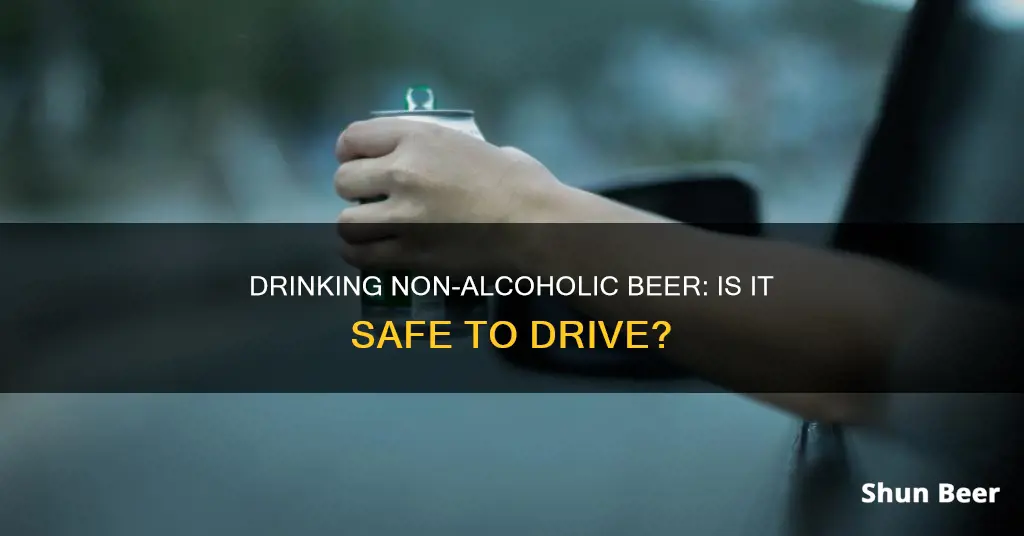
Drinking non-alcoholic beer while driving is a topic that often generates confusion among drivers. While non-alcoholic beer is labelled as such, it may contain a small amount of alcohol, typically under 0.5% alcohol by volume. This leads to the critical question of whether it is both legally and ethically acceptable to drink this beverage while operating a vehicle. The answer to this question depends on various factors, including local laws, individual tolerance, and health.
| Characteristics | Values |
|---|---|
| Legality of drinking non-alcoholic beer and driving | Varies depending on location |
| Typical alcohol content of non-alcoholic beer | Under 0.5% alcohol by volume |
| Legality of drinking non-alcoholic beer with 0.5% ABV | Allowed in Massachusetts and Washington state |
| Legality of drinking non-alcoholic beer with under 0.5% ABV | Allowed in the UK |
| Perceptions of drinking non-alcoholic beer and driving | Perceived as risky behaviour by law enforcement and other drivers |
| Impact on sobriety tests | Presence of any alcohol in the bloodstream may impact results |
| Open container laws | Many states do not allow the consumption of any alcoholic beverage while driving |
| Health and safety considerations | Even minimal alcohol consumption may impair driving ability |
What You'll Learn

Legality of non-alcoholic beer
The legality of drinking non-alcoholic beer and driving varies depending on the jurisdiction. While non-alcoholic beer typically contains less than 0.5% alcohol by volume (ABV), it is not entirely alcohol-free. This means that drinking a significant amount could potentially lead to a slight impairment of driving ability.
In some places, any detectable level of alcohol in a driver's system can have legal consequences. For example, in the United States, some states have zero-tolerance laws where drivers can face DUI (Driving Under the Influence) or DWI (Driving While Intoxicated) charges if found impaired, regardless of the source of the alcohol. In such cases, it is advisable to consult a DWI attorney.
In other places, such as Massachusetts and Washington State, non-alcoholic beer is not considered alcoholic if it contains less than 0.5% ABV. Therefore, drinking and driving with this type of beverage is not illegal, as long as the driver is not impaired.
It is important to note that even if drinking non-alcoholic beer and driving is legal in a particular jurisdiction, it may still be perceived as risky behaviour by law enforcement and other drivers. Additionally, the act of drinking any type of beer while driving may lead to a sense of complacency or distraction, which could potentially impair one's ability to drive safely.
Therefore, it is crucial for drivers to be aware of the local laws and regulations regarding non-alcoholic beer and driving to make informed decisions and ensure their safety and the safety of others on the road.
Ginger Beer: Healthy Daily Habit or Best in Moderation?
You may want to see also

Driving under the influence (DUI)
Drinking non-alcoholic beer and driving is a topic that often generates confusion among drivers. While non-alcoholic beer is labelled as such, it may contain a small amount of alcohol, typically under 0.5% alcohol by volume. This leads to the critical question of whether it is both legally and ethically acceptable to drink this beverage while operating a vehicle.
In some areas, any detectable level of alcohol in a driver's system can have legal consequences. For example, in the United States, a driver with a blood alcohol content (BAC) of 0.08% or higher is considered legally impaired. However, for non-alcoholic beers, which typically contain up to 0.5% alcohol, the legal implications can vary. It's important to be aware of local laws and regulations to avoid legal complications.
Even though non-alcoholic beer contains a minimal amount of alcohol, drivers are advised to exercise caution. The act of drinking any type of beer while driving may lead to a sense of complacency or distraction, and it may still be perceived as risky behaviour by law enforcement and other drivers.
In terms of legal consequences, driving under the influence (DUI) or driving while intoxicated (DWI) charges are serious offences that can result in arrests, fines, license suspensions, jail time, community service, and mandatory alcohol education. These charges can be pressed if consumption leads to impairment, regardless of the BAC threshold.
To ensure safety and adhere to relevant laws, drivers should take certain precautions, such as understanding the product labels, being aware of ingredients that might affect driving ability, arranging for a designated driver when necessary, and limiting the intake of any beverage that might impair driving performance.
In conclusion, while non-alcoholic beer typically falls below the legal limit for alcohol content, it is important to be aware of local laws and regulations, exercise caution, and prioritise safety when consuming these beverages while driving to avoid any legal complications or safety risks.
Beer Drinking in Texas: Can My SO Join?
You may want to see also

Blood alcohol concentration (BAC)
Different levels of BAC can affect you physically and mentally in different ways. For example, a BAC of 0.02% may lead to an altered mood, relaxation, and a slight loss of judgment, while a BAC of 0.08% may result in reduced muscle coordination, impaired judgment, and reasoning. As BAC levels increase, individuals may experience more severe effects such as nausea, vomiting, disorientation, and impaired motor skills.
In most states in the United States, the legal alcohol limit to drive a vehicle for drivers aged 21 or older is 0.08% BAC. However, it is important to note that even if your BAC is below this limit, you can still be charged with drink driving depending on your behaviour on the road.
Non-alcoholic beers typically have a very low alcohol content, usually around 0.5% ABV or less. While drinking non-alcoholic beer will not result in drunkenness or impaired driving ability, it is important to note that some non-alcoholic beers may still contain a small amount of alcohol. Therefore, if you are drinking non-alcoholic beer, it is crucial to check the alcohol content and be mindful of how much you consume, especially if you plan to drive.
Beer Sleeves: Do They Keep Drinks Cool?
You may want to see also

Open container laws
In the context of public places, this refers to openly public places such as sidewalks, parks, and vehicles, but does not include nominally private spaces that are open to the public, like bars, restaurants, and stadiums. An open container typically means that some of the contents have been removed, the seal is broken, the cap is off, or the alcohol is otherwise readily accessible.
It's important to note that open container laws can also apply to legalized cannabis possession in some states. Similar to alcohol-related open container prohibitions, open containers of cannabis or cannabis products are not allowed in the passenger area of a vehicle.
In terms of penalties, violations of open container laws can result in fines, possible jail time, license demerit points, and community service, depending on the state and the specific circumstances of the violation.
Ginger Beer: A Standalone Beverage?
You may want to see also

Driving risks
Drinking non-alcoholic beer and driving is a topic that often generates confusion among drivers. While non-alcoholic beer is labelled as such, it may contain a small amount of alcohol, typically under 0.5% alcohol by volume. This leads to the critical question of whether it's both legally and ethically acceptable to drink this beverage while operating a vehicle.
Legality
The laws regarding the consumption of non-alcoholic beer while driving vary from place to place. In some areas, any detectable level of alcohol in a driver's system can have legal consequences. For example, in the United States, drivers may face DUI (Driving Under the Influence) or DWI (Driving While Intoxicated) charges if found impaired, regardless of the source of the alcohol. In such cases, consulting a lawyer is highly advised.
In the UK, 'drink and drive' is legally defined as having a blood alcohol concentration of more than 0.08%. However, it's important to note that you can still be charged with drink driving if your BAC is below this limit, depending on your behaviour on the road.
Even though non-alcoholic beer contains a minimal amount of alcohol, typically under 0.5%, drivers are advised to exercise caution. The presence of any alcohol in the bloodstream might impact a sobriety test result. Additionally, consuming large quantities of non-alcoholic beer may lead to a sense of complacency or distraction, which could impair one's ability to drive safely.
To ensure safety, drivers should understand the product they are consuming, including confirming the alcohol content and being aware of ingredients that might affect their driving ability. It is also recommended to arrange for a designated driver when necessary and to limit the intake of any beverage that might impair driving performance.
Beer Left in the Car: Still Drinkable?
You may want to see also
Frequently asked questions
Yes, you can drink non-alcoholic beer and drive. However, it's important to note that non-alcoholic beer may contain a small amount of alcohol, typically under 0.5% alcohol by volume.
While non-alcoholic beer is generally considered safe for driving, it's important to be aware of local laws. In some areas, any detectable level of alcohol in a driver's system can have legal consequences.
While non-alcoholic beer is largely considered a safer alternative to alcoholic beverages, the act of drinking any type of beer may lead to a sense of complacency or distraction. It is important to prioritize safety and adhere to relevant laws to prevent impaired driving.
Non-alcoholic beer typically contains a small amount of alcohol, and consuming large quantities may result in slight impairment and impact your reaction times and decision-making.
Driving while impaired can lead to legal repercussions, including arrests, fines, and license suspensions. It is critical to understand the local laws and regulations regarding non-alcoholic beer consumption while driving to avoid any legal complications.







